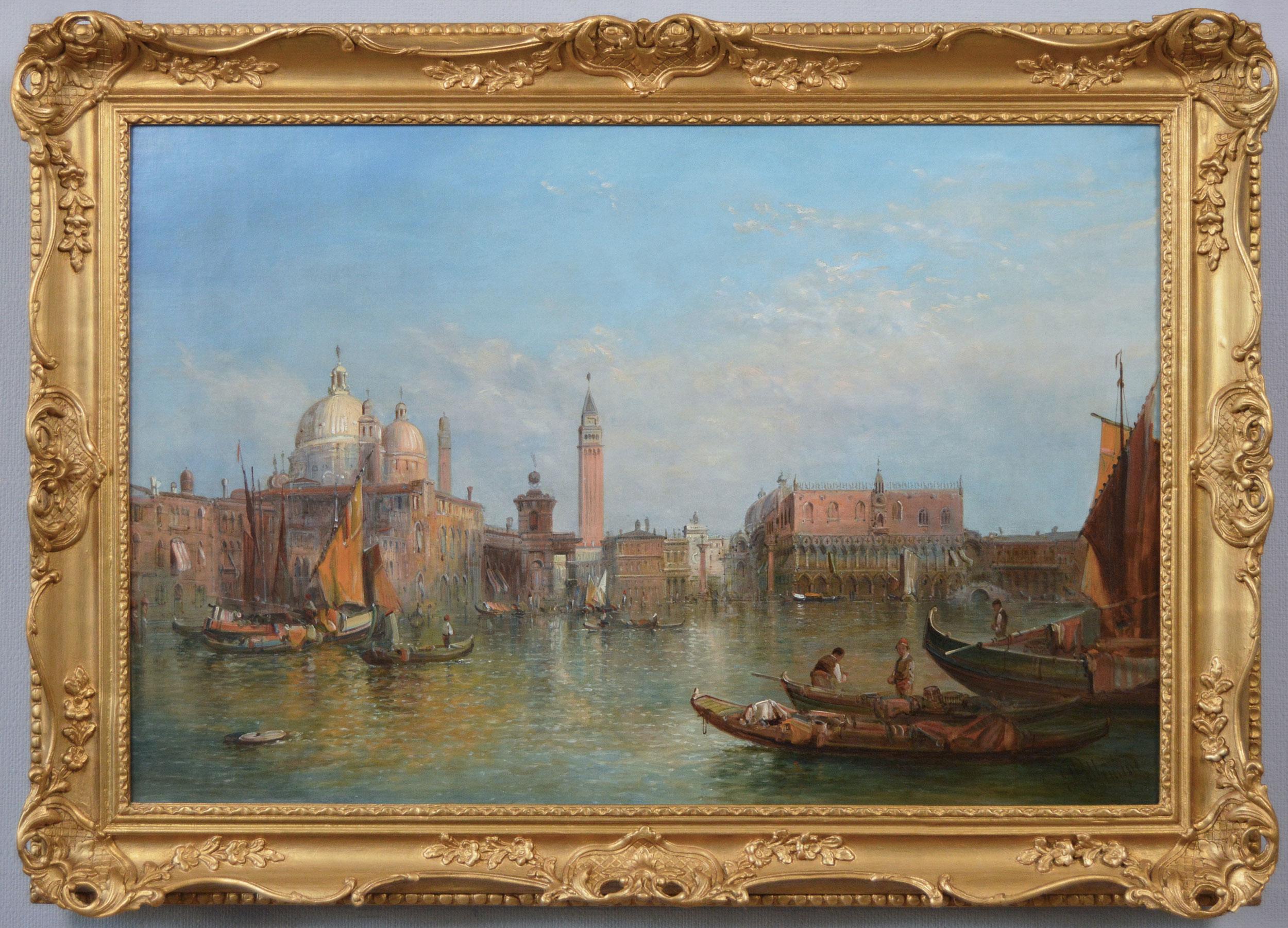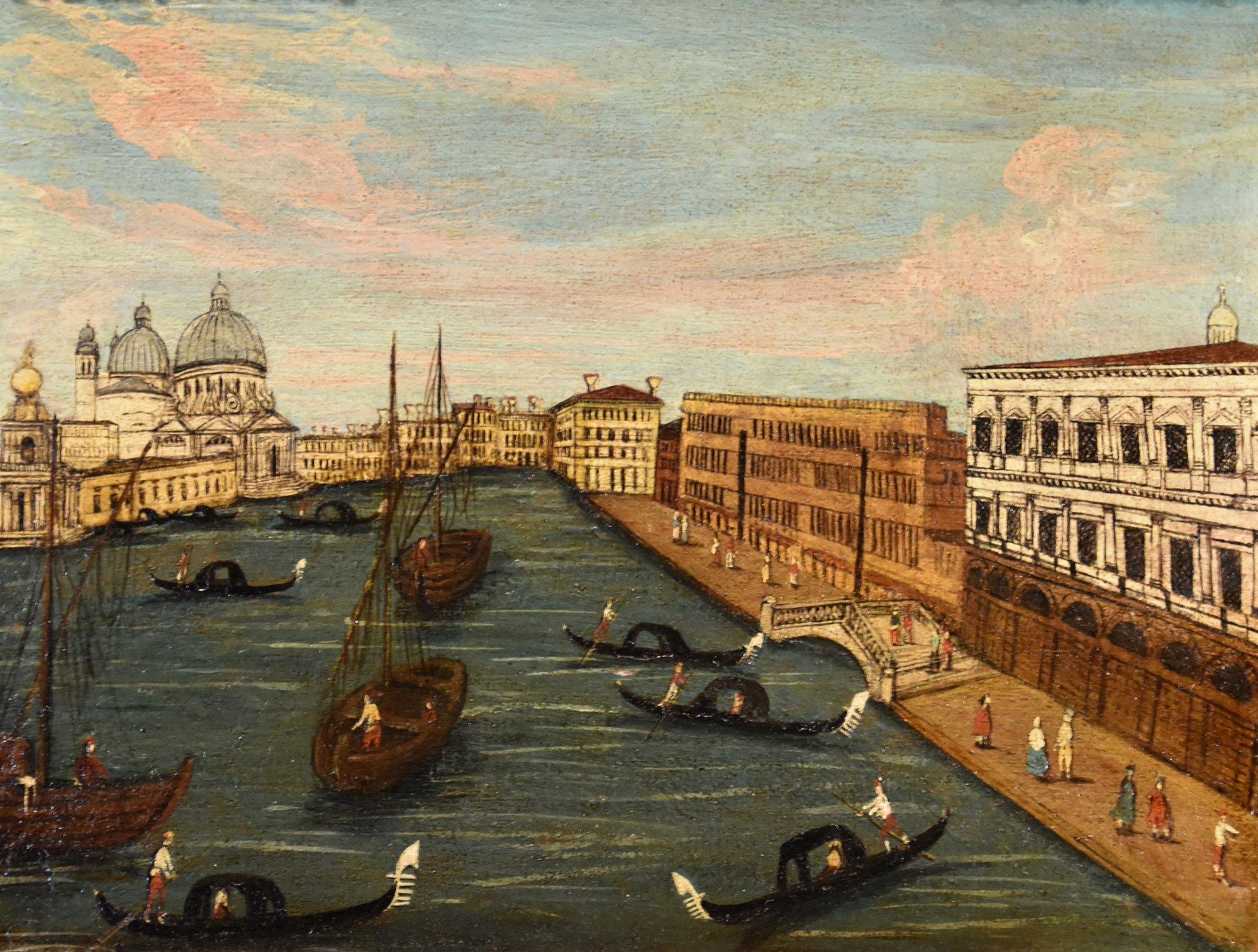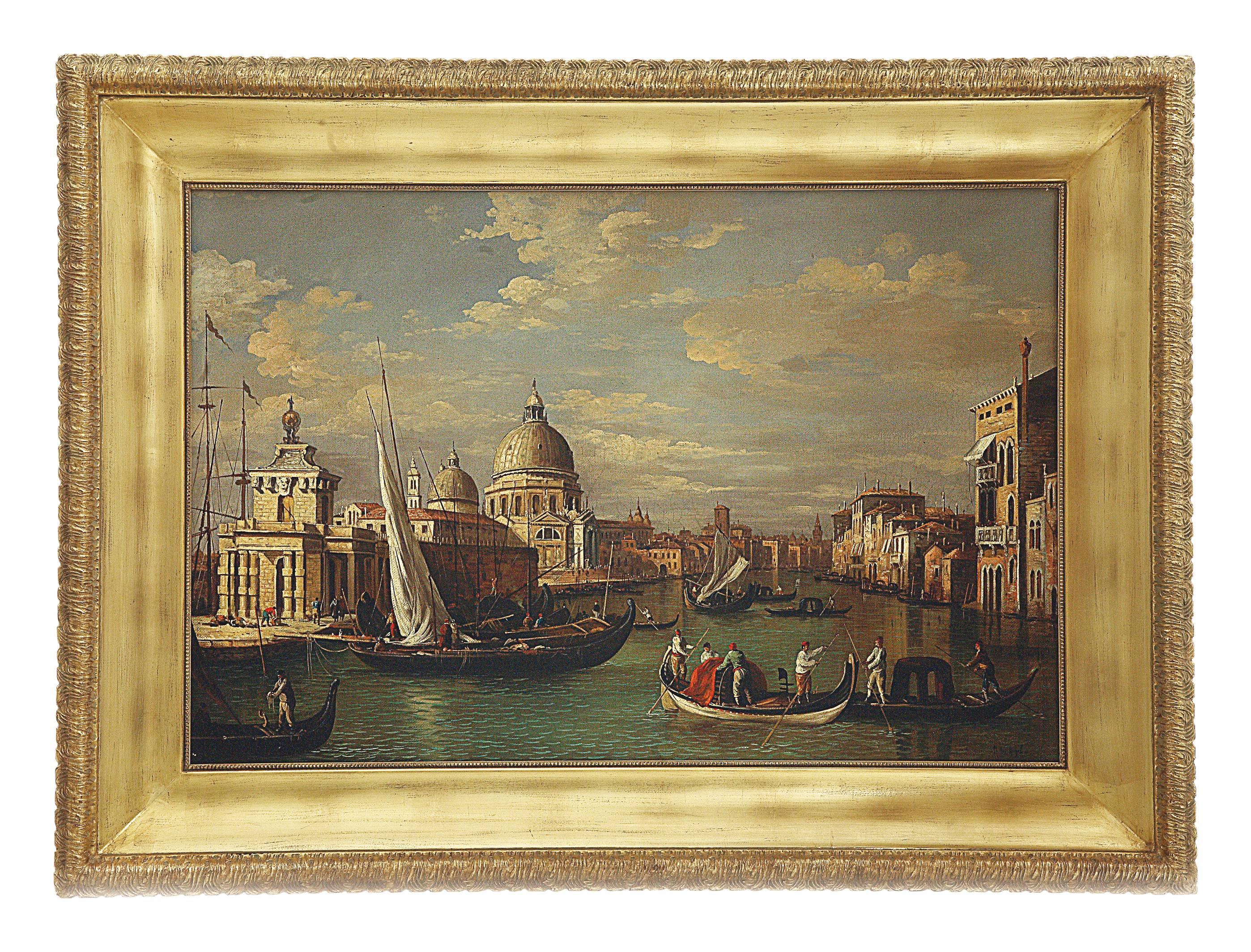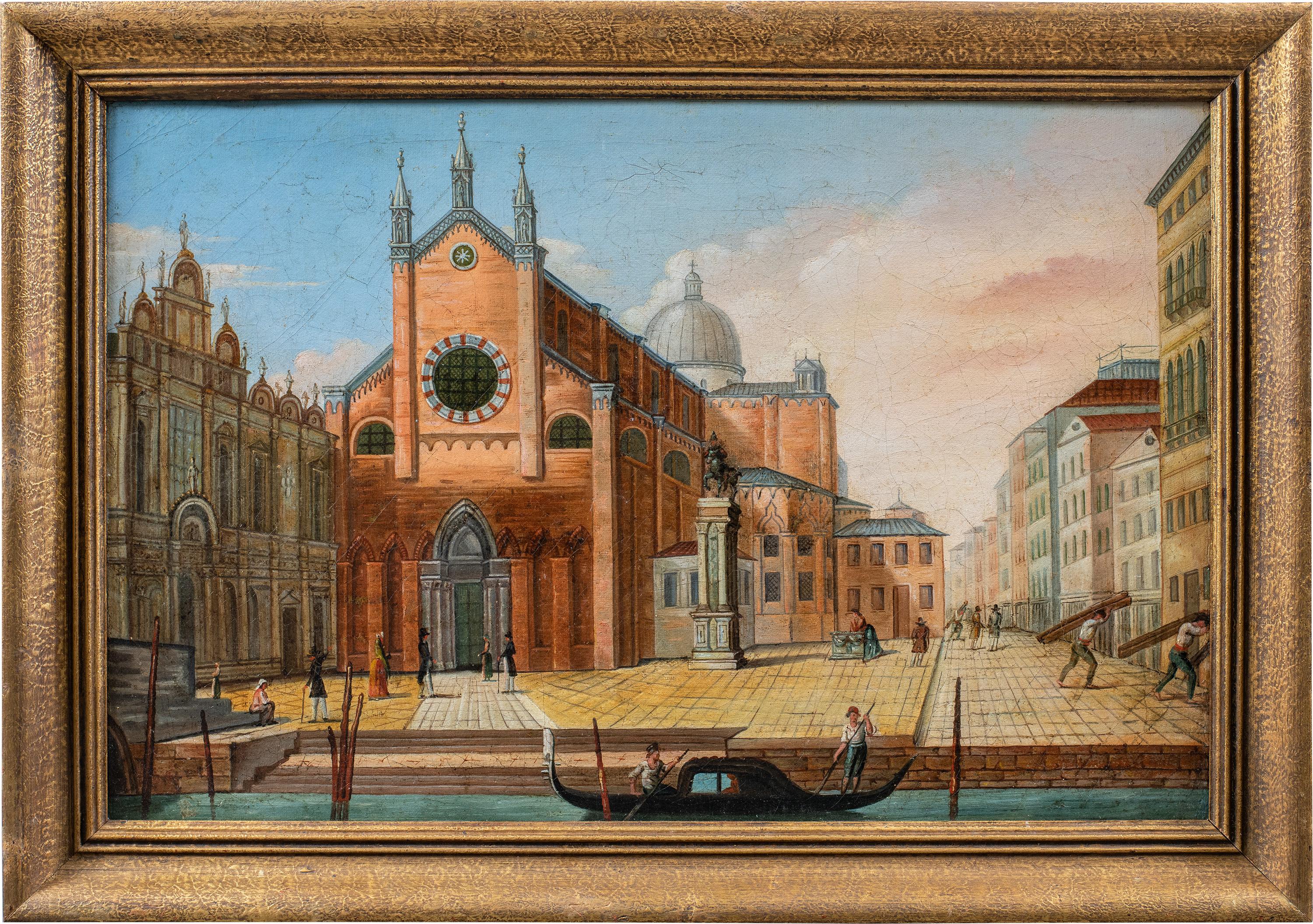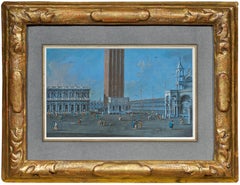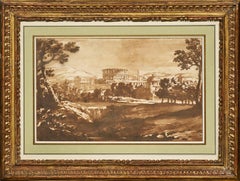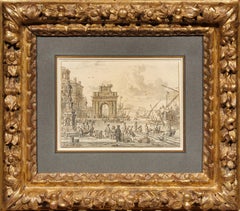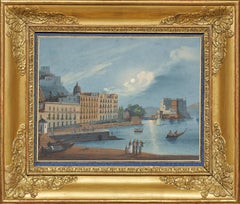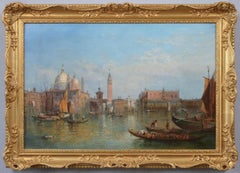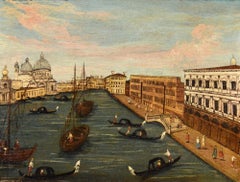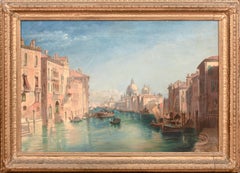Items Similar to View of the Grand Canal, a painting by William James, after Canaletto
Video Loading
Want more images or videos?
Request additional images or videos from the seller
1 of 15
William JamesView of the Grand Canal, a painting by William James, after Canaletto
$97,500
£73,677.53
€85,079.48
CA$136,241.53
A$151,171.46
CHF 79,186.86
MX$1,853,767.89
NOK 1,007,229.60
SEK 950,781.78
DKK 634,491
Shipping
Retrieving quote...The 1stDibs Promise:
Authenticity Guarantee,
Money-Back Guarantee,
24-Hour Cancellation
About the Item
Although we have little bibliographical information on William James, we know that he was trained by Canaletto during the painter's stay in England between 1746 and 1755. Although he may never have been to Venice, William James remained under the influence of his master for a long time and became known for his paintings inspired by Canaletto's artworks.
In this painting, William James is inspired by one of the twelve views of the Grand Canal painted by Canaletto for Joseph Smith, or more precisely by the engraving made by Antonio Visentini in 1735 after this painting. He delivers a very personal version, vibrant with colours, in which he brilliantly reproduces the moving surface of the sea, animated by the ever-changing traffic of the gondolas.
1. William James, the English follower of Canaletto
The life of William James, who worked as a vedutist between 1754 and 1771, remains largely an enigma. While we have no precise biographical data, Edward Edwards reports in his Anecdotes of Painters (published in 1808) that James was a pupil or an assistant of Antonio Canal, known as Canaletto (1697 - 1778) during his stay in England between 1746 and 1755. This collaboration had a decisive influence on the work of William James, who later largely imitated Canaletto's Venetian views, which were so fashionable at the time, but also the London paintings of Samuel Scott. James lived for some years in Maiden Lane, Covent Garden, and then at the Golden Head in May's Buildings, St Martin's Lane, an area of London popular with artists and craftsmen.
James exhibited at the Society of Artists of Great Britain from 1761 to 1768 and at the Royal Academy from 1769 to 1771. He became a member of the Society of Artists in 1766. Most of the paintings he exhibited were views of London, but he also produced a series of Egyptian temples which he exhibited at the Society of Artists in 1768 and at the Royal Academy between 1769 and 1771 (where he also exhibited a View of the Grand Canal in Venice in 1771).
It is thought that James never left England, so these Egyptian images must have been based on the sketches of an unknown traveller. As for his views of Venice, which are the most sought-after part of his work, he was mainly inspired, as we shall see in more detail, by Antonio Visentini's Prospectus Magni Canalis Venetiarum, a collection of engravings based on Canaletto's paintings.
2. From Canaletto's painting to Visentini's engraving
In 1727 Canaletto painted a View of the Grand Canal to the West, from the Vendramin-Calergi Palace in San Geremia (10th picture of the Gallery). This view was acquired with the entire Joseph Smith’s collection by King George III in 1762 and is now part of the Royal Collection. This view is part of a set of twelve paintings commissioned from Canaletto by Joseph Smith, an Englishman based in Venice who had become Canaletto's dealer.
This set was probably made between 1722 and 1732; two festival scenes painted between 1733 and 1734 were added to this set. These fourteen scenes were then engraved by Antonio Visentini and published under the title Prospectus Magni Canalis Venetiarum by Pasquali in 1735. It should be noted that they were engraved in reverse and that the engravings therefore appear in the same direction as the original paintings.
On the right, Canaletto depicts the imposing Renaissance façade of Palazzo Vendramin-Calergi, commissioned in 1481 from Mauro Codussi. Canaletto mistakenly added a balustrade to the second floor and depicted two arched windows on either side of the doorway opening onto the canal - there should only be one on each side, flanked by a rectangular window (Canaletto had drawn the palace correctly in his sketchbook). In the distance is the tower of San Geremia, correctly proportioned but perhaps slightly off to the right. Canaletto has shown three openings instead of two on each side of the bell tower. The windows of the adjacent church are also very inaccurately depicted.
To the left, in the shadows, are the Ca' Tron and the Palazzo Belloni-Battagia. Beyond we see the brick facade of the fifteenth-century granaries, the Deposito del Megio, followed by the Fondaco dei Turchi, built in the thirteenth century as an office and used as warehouse for Turkish merchants between 1621 and 1838. The Deposito is normally set back from Palazzo Belloni-Battagia, as the canal curves to the left at this point. Canaletto has flattened and straightened the left bank of the canal to show the Deposito and the Fondaco, which would normally be half hidden, and the two sunlit buildings at the back, which would not be visible at all.
We have reproduced above the engraving by Visentini in which he corrected the inaccuracies introduced by Canaletto, particularly in the façade of Palazzo Vendramin-Calergi (last photo of the Gallery).
3. The originality of William James' painting
It is quite possible that William James saw Canaletto's painting in London after it was bought by George III, but it seems certain that his first source of inspiration was Visentini's engraving. The treatment of the façade of the Vendramin-Calergi palace (to the right of the canal) is based upon Visentini's engraving, and therefore does not include the changes introduced by Canaletto. The Tower of San Geremia is also shown with its two openings on each side.
While William James remains faithful to Visentini, and thus to Canaletto's original model, in the general arrangement of the various buildings, the chromatic range takes us away from the Venetian model, towards an explosion of enchanting colors. The orange-red colors of the palaces (inspired by those of English facades) stand out clearly in the cooler light, evoking the atmosphere of the banks of the Thames, which James also depicted on many occasions.
This freedom in the choice of colors confirms the hypothesis that James was mainly inspired by Visentini's engraving, which he had the delicate task of transcribing into color.
While the architectural setting is faithfully reproduced, the painting is enlivened by numerous innovations in the positioning of the characters and by the gondola traffic that animates the canal. Whereas Canaletto had two large red hangings on either side of the canal, James, perhaps inspired by festival scenes, introduces numerous colorful hangings that enliven the windows of the palaces, both on the right and left sides of the canal.
The position of the gondolas is also quite different: James is pushing them higher up in the composition, clearing the moving space of the canal. We can almost perceive the light sea breeze blowing across the quivering waters, in which the sky and the façades of the palaces are reflected, as well as the numerous gondolas whose passengers are finely depicted.
4. Framing
This vivid painting is presented in a gilded wooden frame in the neo-classical style.
Main bibliographic reference :
Rozie Razzal & Lucie Whitaker - Canaletto & the Art of Venice - Royal Collection Trust London 2017
- Creator:William James (1882 - 1961, American)
- Dimensions:Height: 30.69 in (77.96 cm)Width: 45.69 in (116.06 cm)
- Medium:
- Movement & Style:
- Period:
- Condition:24 3/8” x 39 3/8” (62 x 100 cm) - framed 30 11/16” x 45 11/16” (78 x 116 cm) Provenance: Paris Private collection. This painting probably originally came from an English collection as indicated by the English label on the back of the frame.
- Gallery Location:PARIS, FR
- Reference Number:1stDibs: LU1568212305222
About the Seller
5.0
Vetted Professional Seller
Every seller passes strict standards for authenticity and reliability
Established in 2020
1stDibs seller since 2021
10 sales on 1stDibs
Typical response time: 2 hours
- ShippingRetrieving quote...Shipping from: PARIS, France
- Return Policy
Authenticity Guarantee
In the unlikely event there’s an issue with an item’s authenticity, contact us within 1 year for a full refund. DetailsMoney-Back Guarantee
If your item is not as described, is damaged in transit, or does not arrive, contact us within 7 days for a full refund. Details24-Hour Cancellation
You have a 24-hour grace period in which to reconsider your purchase, with no questions asked.Vetted Professional Sellers
Our world-class sellers must adhere to strict standards for service and quality, maintaining the integrity of our listings.Price-Match Guarantee
If you find that a seller listed the same item for a lower price elsewhere, we’ll match it.Trusted Global Delivery
Our best-in-class carrier network provides specialized shipping options worldwide, including custom delivery.More From This Seller
View AllView of Piazza San Marco, a tempera signed by Giacomo Guardi (1764 - 1835)
Located in PARIS, FR
Signed and localized on the verso :
"Vedute di parte dalla Piazza dif.a alla Loggetta e cam
panil parte della Zecca ed in lontan Proc.e vechie e parte della chiesa
punto preso vic...
Category
Early 19th Century Old Masters Landscape Drawings and Watercolors
Materials
Tempera
View of an Antique City, a wash landscape by Jan de Bisschop (1628 - 1671)
Located in PARIS, FR
The attribution to Jan de Bisschop has been confirmed by the RKD with the following comment: "We base this attribution on the dark washes, the subject represented and the monogram".
...
Category
17th Century Old Masters Landscape Drawings and Watercolors
Materials
Pen, Ink
Imaginary View of an Italian Port, a signed and dated drawing by Jacobus Storck
Located in PARIS, FR
In this finely executed pen and wash drawing, Jacobus Storck presents us with an imaginary view in an Italian port. The splendor of the buildings (the large sculpted fountain surmoun...
Category
1680s Old Masters Landscape Drawings and Watercolors
Materials
Paper, Pencil, Pen, Ink
View of the Ovo Castle in the Moonlight, a 19th century Neapolitan gouache
Located in PARIS, FR
Neapolitan gouaches appeared in the eighteenth century when tourism in the Naples area was developing: the discoveries of Herculaneum and Pompeii made this city a mandatory stop on the Grand Tour, the journey made by wealthy Europeans to complete their education.
Generally small in size for ease of transport and affordable in price, these gouaches were the ideal travel souvenir that these tourists of the early days were bringing back to capture the idyllic landscapes they had discovered during their journey and to share them with family and friends upon their return at home.
The Bay of Naples and the eruptions of Vesuvius are the favourite themes of these views. Here we have a view of the Ovo Castle, which was rebuilt on the island of Partenope, in the middle of the Bay of Naples and about a hundred metres from the shore by the Normans in the 12th century on antique ruins...
Category
Early 19th Century Romantic Landscape Drawings and Watercolors
Materials
Paper, Gouache
View of the Posillipo coastline near Naples by William Marlow (1740 - 1813)
By William Marlow
Located in PARIS, FR
In this drawing, inspired by his stay in Naples in 1765, William Marlow presents us with a view of Cape Posillipo, to the west of Naples, an essential stage during the Grand Tour. Th...
Category
1760s Old Masters Landscape Drawings and Watercolors
Materials
Ink
River Landscape with Shepherds and Architecture, a painting by Jan van Bunnik
By Jan van Bunnik
Located in PARIS, FR
This painting has been the subject of a study by the art historian Fabrizio Dassie (available on request), confirming its inclusion in Jan van Bunnik’s corpus.
In this painting, Ja...
Category
Late 17th Century Old Masters Landscape Paintings
Materials
Copper
You May Also Like
19th Century oil painting of The Grand Canal Venice towards St Marks Square
By Alfred Pollentine
Located in Nr Broadway, Worcestershire
Alfred Pollentine
British, (1844-1910)
The Grand Canal looking towards St Marks Square & the Doge’s Palace, Venice
Oil on canvas, signed
Image size: 19.25 inches x 29.25 inches
Size including frame: 25.25 inches x 35.25 inches
A wonderful view of the Grand Canal featuring the Doge’s Palace and St Mark’s Square, Venice by Alfred Pollentine. The scene shows the entrance to the Grand Canal with the Santa Maria Della Salute with its distinctive rotunda and the Dogana to the left. Ahead can be seen the bell tower of St Mark’s with the Doges palace to its right.
Alfred William Pollentine was born in St Pancras, London on 26 August 1844, the son of William Pollentine, a carver gilder and picture dealer and Caroline Smith. After the death of his father in 1856, his mother married the artist Adam Barland...
Category
19th Century Victorian Landscape Paintings
Materials
Canvas, Oil
View Venice Grand Canal See Landscape 18th Century Paint Oil on canvas Venice
Located in Riva del Garda, IT
Vedutist painter of the 18th century
View of Venice with the Grand Canal, the Punta della Dogana with the Basilica of Santa Maria della Salute on the left, the Palazzo Della Zecca wi...
Category
18th Century Old Masters Paintings
Materials
Oil
VENICE - In the Manner of Canaletto -Italian Landscape Oil on Canvas Painting
By Mario De Angeli
Located in Napoli, IT
Venice - Mario De Angeli - Italia 2008 - Oil on canvas cm. 75x150.
Mario De Angeli's canvas is an extraordinary work of Italian landscape painting.
They are inspired by the landsc...
Category
Early 2000s Italian School Landscape Paintings
Materials
Gold Leaf
The Grand Canal, Venice, 19th Century by Edward Angelo GOODALL (1819-1908)
By Edward Angelo Goodall
Located in Blackwater, GB
The Grand Canal, Venice, 19th Century
by Edward Angelo GOODALL (1819-1908)
Large 19th Century view of the Grand canal, Venice, oil on canvas by Edward Angelo Goodall. Excellent qua...
Category
19th Century Landscape Paintings
Materials
Canvas, Oil
$3,855 Sale Price
20% Off
VENICE -In the Manner of Canaletto- Italian Landscape Oil on Canvas Painting
By Mario De Angeli
Located in Napoli, IT
Venice - Mario De Angeli - Italia 2009 - Oil on canvas cm. 80x120.
Gold leaf gilded wooden frame ext. mis. cm.100x140
Mario De Angeli's canvas is an extraordinary work of Italian l...
Category
Early 2000s Old Masters Landscape Paintings
Materials
Gold Leaf
Vedutist Venetian painter - 19th century landscape painting - Venice view
Located in Varmo, IT
Venetian painter (19th century) - Venice, view of Campo Santi Giovanni e Paolo.
40 x 63 cm without frame, 49 x 70.5 cm with frame.
Antique oil painting on canvas, in an antique gil...
Category
Mid-19th Century Realist Landscape Paintings
Materials
Canvas, Oil
$2,623 Sale Price
51% Off
Free Shipping
More Ways To Browse
Old Masters Renaissance Paintings
Old Brick
Painting Antique Windows
English Renaissance Painting
Renaissance 18th Century Painting
William King Artist
James King Artist
Old Masters Paintings Of Venice
William Bell
Painting Of Venice Canals
Landscape Oil Painting Egypt
18th Century British Landscapes
Large Rectangular Paintings
James Tower
Old Antique Bells
Gondola Painting
Grand Canal Venice
William Temple
